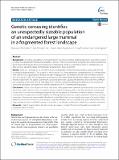Files in this item
Genetic censusing identifies an unexpectedly sizeable population of an endangered large mammal in a fragmented forest landscape
Item metadata
| dc.contributor.author | McCarthy, M.S. | |
| dc.contributor.author | Lester, J.D. | |
| dc.contributor.author | Howe, Eric John | |
| dc.contributor.author | Arandjelovic, M. | |
| dc.contributor.author | Stanford, C.B. | |
| dc.contributor.author | Vigilant, L. | |
| dc.date.accessioned | 2015-10-06T14:10:04Z | |
| dc.date.available | 2015-10-06T14:10:04Z | |
| dc.date.issued | 2015-08-25 | |
| dc.identifier | 221891241 | |
| dc.identifier | 13ed53c4-15f9-49c5-a8b0-f61c69b6730e | |
| dc.identifier | 84940175671 | |
| dc.identifier | 000360034400001 | |
| dc.identifier.citation | McCarthy , M S , Lester , J D , Howe , E J , Arandjelovic , M , Stanford , C B & Vigilant , L 2015 , ' Genetic censusing identifies an unexpectedly sizeable population of an endangered large mammal in a fragmented forest landscape ' , BMC Ecology , vol. 15 , no. 1 . https://doi.org/10.1186/s12898-015-0052-x | en |
| dc.identifier.issn | 1472-6785 | |
| dc.identifier.uri | https://hdl.handle.net/10023/7614 | |
| dc.description | This study was funded by the American Society of Primatologists, the German Academic Exchange Service (DAAD), the Max Planck Society, the University of Southern California Jane Goodall Research Center and Dornsife College of Letters, Arts, and Sciences, the Nacey Maggioncalda Foundation, and Primate Conservation, Inc. | en |
| dc.description.abstract | Background: As habitat degradation and fragmentation continue to impact wildlife populations around the world, it is critical to understand the behavioral flexibility of species in these environments. In Uganda, the mostly unprotected forest fragment landscape between the Budongo and Bugoma Forests is a potential corridor for chimpanzees, yet little is known about the status of chimpanzee populations in these fragments. Results: From 2011 through 2013, we noninvasively collected 865 chimpanzee fecal samples across 633 km2 and successfully genotyped 662 (77%) at up to 14 microsatellite loci. These genotypes corresponded to 182 chimpanzees, with a mean of 3.5 captures per individual. We obtained population size estimates of 256 (95% confidence interval 246-321) and 319 (288-357) chimpanzees using capture-with-replacement and spatially explicit capture-recapture models, respectively. The spatial clustering of associated genotypes suggests the presence of at least nine communities containing a minimum of 8-33 individuals each. Putative community distributions defined by the locations of associated genotypes correspond well with the distribution of 14 Y-chromosome haplotypes. Conclusions: These census figures are more than three times greater than a previous estimate based on an extrapolation from small-scale nest count surveys that tend to underestimate population size. The distribution of genotype clusters and Y-chromosome haplotypes together indicate the presence of numerous male philopatric chimpanzee communities throughout the corridor habitat. Our findings demonstrate that, despite extensive habitat loss and fragmentation, chimpanzees remain widely distributed and exhibit distinct community home ranges. Our results further imply that elusive and rare species may adapt to degraded habitats more successfully than previously believed. Their long-term persistence is unlikely, however, if protection is not afforded to them and habitat loss continues unabated. | |
| dc.format.extent | 1932568 | |
| dc.language.iso | eng | |
| dc.relation.ispartof | BMC Ecology | en |
| dc.subject | Habitat fragmentation | en |
| dc.subject | Genetic census | en |
| dc.subject | Ecological corridor | en |
| dc.subject | Chimpanzee | en |
| dc.subject | Population estimate | en |
| dc.subject | Pan troglodytes | en |
| dc.subject | Mark recapture | en |
| dc.subject | QH301 Biology | en |
| dc.subject | DAS | en |
| dc.subject.lcc | QH301 | en |
| dc.title | Genetic censusing identifies an unexpectedly sizeable population of an endangered large mammal in a fragmented forest landscape | en |
| dc.type | Journal article | en |
| dc.contributor.institution | University of St Andrews. School of Mathematics and Statistics | en |
| dc.identifier.doi | 10.1186/s12898-015-0052-x | |
| dc.description.status | Peer reviewed | en |
| dc.identifier.url | http://www.biomedcentral.com/1472-6785/15/21/additional | en |
This item appears in the following Collection(s)
Items in the St Andrews Research Repository are protected by copyright, with all rights reserved, unless otherwise indicated.

